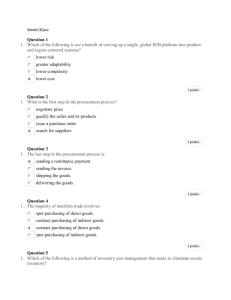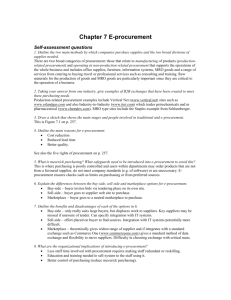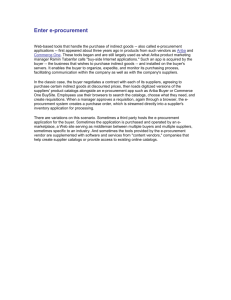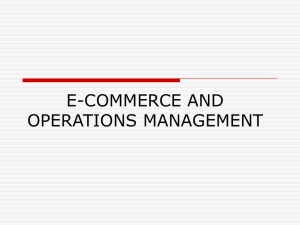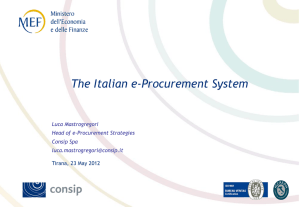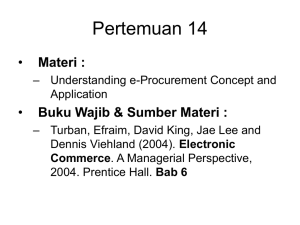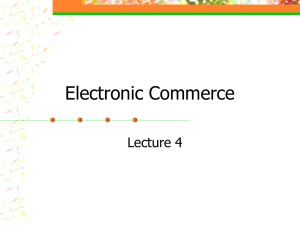Public e-Procurement in Italy Journal of Information, Law and Technology
advertisement
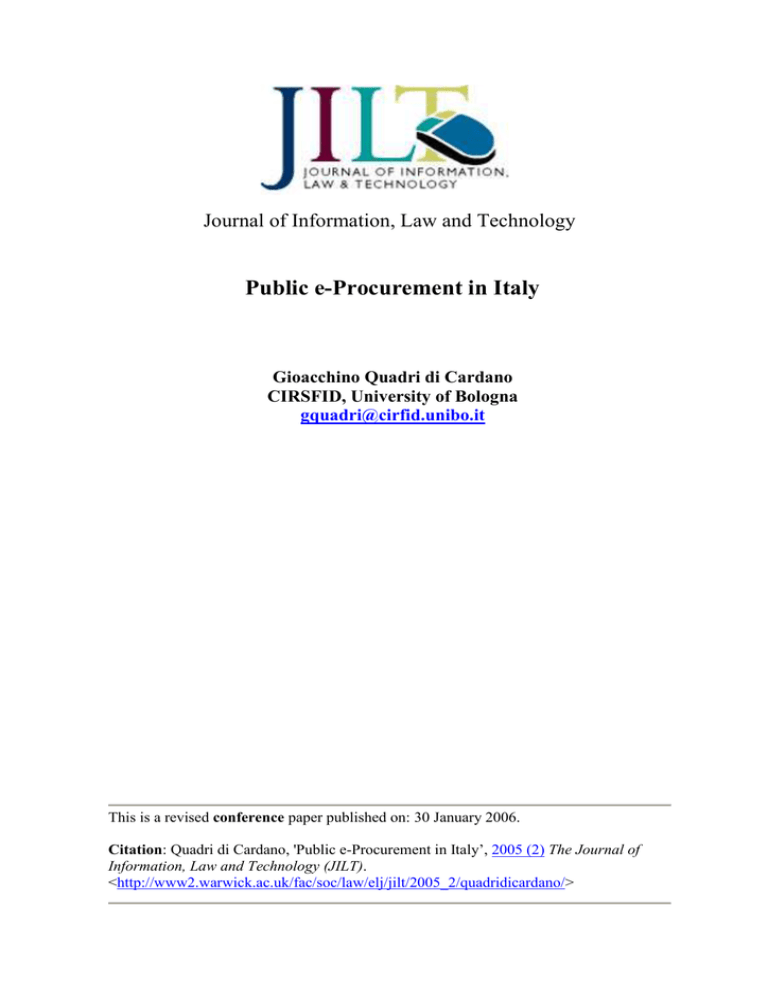
Journal of Information, Law and Technology Public e-Procurement in Italy Gioacchino Quadri di Cardano CIRSFID, University of Bologna gquadri@cirfid.unibo.it This is a revised conference paper published on: 30 January 2006. Citation: Quadri di Cardano, 'Public e-Procurement in Italy’, 2005 (2) The Journal of Information, Law and Technology (JILT). <http://www2.warwick.ac.uk/fac/soc/law/elj/jilt/2005_2/quadridicardano/> Abstract Since 1999 Italy has started to digitalize the purchase processes of public administrations adopting different public e-procurement models. After the self-evident success of electronic shops, since 2002 on-line auctions and marketplaces are being tested. The final goal is not only cost reduction, since public e-procurement can bring important benefits for transparency, competitiveness, and efficiency. Keywords: e-Procurement, Consip model, on-line auctions, virtual marketplace. 1. Introduction Italian public administration is used to purchase goods and services resorting to private law contracts and, more exactly, to that specific contract that we call “contratto di appalto” and that is defined by article 1655 of the civil code. In force of this contract one party -called appaltatore- engages himself in exchange of money to realize a work or to supply a good or a service, organizing the necessary means and equipments, and assuming all the management risks. However, if the contractual relationship between the public administration and the undertaker is entirely regulated by private law, the choice of the contractor must be made following procedures1 that are set by public law2, in order to guarantee the respect of those fundamental principles of the administrative action that are present also in many other legal systems, such as transparency, efficiency, parity of the tenderers, and similars. Therefore the legal doctrine uses to distinguish, into the purchasing process, a public stage that ends with the selection of the better offer and a private one that starts with the subscription of the contract. In the last five years, Italy -as well as other European countries- has been experimenting with public e-procurement, which is that set of legal rules and technologies that allow public administration to purchase goods and services using electronic methods in every stage of the purchasing process, from identification of requirement through to payment, and potentially to contract management3. Indeed public e-procurement is one of the 10 main objectives that the Italian government has fixed in its Guidelines for the Development of the Information Society4 and is an important step in the process of modernization and digitalization of the public administration5. Moreover those guidelines, and particularly e-procurement, are compliant with the e-Europe 2002 and e-Europe 2005 action plans6, that will be integrated by the forthcoming European Directive on on-line tenders7. If cost saving8 is obviously the main reason of interest for our governments, it is actually clear that e-procurement can bring important benefits, such as a higher transparency of the administrative action, an important simplification of the processes, and greater efficiencies that arise from the better monitoring of needs and costs, from the higher competition between tenderers, as well as from the possibility for the public administrations to interact with the contracting firms. Internet and computer technology can be used in both public and private phases, by this way creating different models of hybrid e-procurement, although it is clear that the final goal is the digitalization of the whole process. 2. The Consip Model Budget laws of 2000, 2001 and 20029 have introduced the possibility for the Ministry of Economics and Finances to stipulate frame contracts with contracting parties selected using public evidence procedures, that engage themselves to supply to ordering administrations goods or services at the conditions and under an amount that have been previously set in the frame contract (art. 26, L. 488/1999). It is a centralized purchase system that aims at consolidating the demand of goods and services in order to have higher rebates and a higher competitiveness between tenderers. Draws up the agreements Defines standards Surveys the expenses Agreement Procurement Defines needs Consumes in the limits of the agreement Picture 1 - The Consip Model The Ministry has permanently delegated with a decree of 24th February 2000 the realization, the management and the control of the procedures for the stipulation of the draft contracts, as well as the execution of all the informatic and telematic services, to Consip10 SpA, a public limited company with an exclusive mission to provide services as well as technological and know-how support to the government and to public administrations. Most of all Consip is called to co-operate with public administrations to monitor their needs in order to call for tenders for the stipulation of frame agreements. The process is quite simple and starts with the publication of a call for bids, which invite tenderers to send offers for the supply of a catalog of goods or services. The selection of the best bidder can be made using traditional procedures as well as with an on-line auction (see paragraph 2). Then Consip stipulates the frame contract with the winning tenderer, and the contract is published on Consip’s portal11 in the form of an on-line catalogue. Electronic Electronic Catalogues Catalogs Catalogs On On line line Auctions Auctions Market Market Place Place Purchase within frame contracts Address specific requests Virtual market Goods and services: • Standardized • Low price volatility • Slow obsolescence Goods and services: • Specialized • High price volatility • Rapid obsolescence Ideal for goods frequently purchased : • Low cost • Standardized • Highly fragmented Picture 2 - The CONSIP's Web Portal Consip’s web site is the main core of the Italian public e-procurement system, since there is the electronic platform that enables public administration to enter in contact with tenderers to adhere to frame contracts. The purchase process will be perfected and the public administration will be bound (legally and financially) only when official authorized to purchases will send the order using Consip’s web site. All state administrations12 are bound to use those on-line catalogues to purchase goods and services, while other public administrations are only encouraged to use this procurement system, although they have to comply with the same quality and prince standards. Since this system is particularly suitable for purchasing big amounts of standardized goods and services, Consip has been charged by the Ministry (art. 59 of Law 388/2000) to promote unions of non-state public administration of the same nature (such as universities, hospitals, cities and regions) that consequently have similar need of goods and services, in order to elaborate common purchase strategies and stipulate frame contracts to which those unions can subscribe. The so-called “Consip Model” has immediately bring important benefits, as witnessed by the increasing number of registered administrations (from 1200 in January 2001 to 16650 in August 2002) and of orders (from 850 in January 2001 to 91200 in August 2002), with an average saving of 28,5% (see table 1). Goods Utilities TLC Productivity SW Laptop PCs Printers Desktop PCs Fax Machines Cars Stationery Meal coupons Facility Management Fuels Electric Power Mobile phone contracts Fixed phone contracts Telephone exchanges 39 35 30 25 25 15 15 9 15 10 - 20 10 75 58 30 Table 1- Unit cost reduction (source: Consip) The success of the system is confirmed by the fact that, in order to profit of the low prices obtained thanks to those frame contracts, many public administrations have made a kind of “race” to buy as many goods and service as possible at the lowest price, by this way exhausting too quickly the agreed amounts. For this reason in the most recent frame contracts a clause is inserted by which, in case of exhaustion of the maximum amount before the end of the contract, the supplier is engaged to increase this amount at the same conditions. Anyway this system has been questioned under the new federal order of the state, that would not be compatible with a highly centralized model like this one13. 3. On-line Auctions The first applications of the Consip model have used traditional tender procedures in order to identify the contractor. However the Presidential Decree 4th April 2002 no. 10114 has introduced the possibility to make on-line reverse auctions, using an automatic and centralized Internet-based negotiation system that can assess the offers through economic and technical criteria, and select the winning tenderer. This system has been realized and is currently managed by Consip. Since the access to the electronic platform is limited to qualified tenderers, according to article 9 of the aforementioned decree, at least 60 day before the auction, the administration must publish a public notification to invite potential tenderers to send an application for being qualified and registered to the system. The notification must specify: the content of the application and the modality that must be followed to send it to the public administration; the product categories the applicant will be qualified for; modalities and criterions that will be followed for the presentation and the evaluation of the applications, particularly as regards economic, financial and technical capacity of the applicants, as well as the fulfillment of the subjective and objective requirements; the site where will be available the documents and information concerning the auction; the official responsible of the administrative procedure; the life of the user’s qualification, that can not be longer that 24 months; and the previous guarantees that the users will have to produce before being qualified to the electronic negotiation system. Applications must be resolved within 15 days from their receipt, and -if accepted- the administration must communicate the ID and password requested to access to the system, as well as the categories and classes of goods and service the applicant have been registered to. Of course, qualified tenderers must continue to fulfill the objective and subjective requirements fixed by the notification during the validity period of the registration. Registered users will be admitted to send offers for the products they have been qualified for, and for all the auctions that the administration will call during the period indicated in the notification. At least 30 days before each auction, a public announcement of the auction is made, where are specified all the information that were in the previous notification as that will permit to unregistered people to send their application, as well as: all the terms and conditions of the supply of goods or services, the amount and the characteristics of such goods or services, the place where the goods must be delivered or the service will be made, and all the other elements of the future contract; the criteria that will be followed to evaluate the offers; and the supplementary guarantees that the tenderers will have to produce before the auction. The public announcement is send by electronic email together with an official invitation to all the registered users at least 10 days before the starting of the auction; in the same lapse of time the administration must also evaluate the applications sent by unregistered users. Since the auction starts, the registered users will be able to send their offer, that are evaluated in real-time by the system and shown on a list in order to allow users to make other bids until the closing time. It is important to notice that with the winner of every single auction, Consip or the interested administration will draw up a single supply contract or a frame contract. In this system all the communications must be made in electronic format, and all the messages and acts must be signed using an asymmetric key based electronic signature15. Video projectors 7/9/2001 Chemical hoods 14/2/2002 Waste disposal 24/4/2002 Auction responsible: Consip Buyer: aggregation of 5 Universities (Bologna, Padua, Bari, Milan, Turin) Auction base price: 196.000 € Achieved saving: 28% Auction responsible: University of Bologna Buyer: aggregation of 3 Universities (Bologna, Padua, Bari) Auction base price: 70.000 € Achieved saving: 31% Action responsible: Politecnico di Milano Buyer: Politecnico di Milano Auction base price: 186.000 € Achieved saving: 49% Table 2 - Experimental Auctions' Results On-line auctions have been specially conceived when the administration needs to purchase goods or service with special characteristics, such as scientific instruments, or for a low amount. The electronic process reduces participation costs to suppliers and cuts tender time and cost, simplifying the entire supplier selection process. The system also assures transparency, safety and par condicio among participating suppliers. Even if this e-procurement model as regulated by the Decree of April 2002 has not been implemented yet, experimental on-line auctions have led to very encouraging results (see table 2). The future use of intelligent agent based auction systems will permit to implement automatic bid evaluation not only for auctions based on the criteria of the lower price or of the higher rebate, but also for those that are awarded to the economic most advantageous offer. 4. The Public Administrations’ Virtual Marketplace The virtual marketplace of the public administrations has been introduced by article 11 of the Presidential Decree 101/200216 and its peculiarity is that the ordering public administration does not directly find there goods or services, but suppliers that have been pre-qualified to provide certain categories of goods and services at the end of an electronic-based qualification procedure17. This purchase system has been conceived only for purchases below the European threshold for goods and services of 200.000 €, since the provision of a market limited to a close number of qualified suppliers is not compatible with European Directives on public tenders no. 77/62/CEE, 80/767/CEE and 88/295/CEE. The virtual marketplace is currently being tested by Consip, with the support of two joint ventures made by IBM Italia, Intesa SpA and Sistemi Informativi SpA on the one hand, AT Kearney SpA, Fabbrica Servizi Telematici Srl and Electronic Data Systems Italia on the other hand, that have been charged by Consip of the technical management of the experimental marketplace. Each ordering unit18 of every administration can register to the marketplace sending an application form subscribed using digital signature. Registered administrations are provided by the marketplace’s manager with an electronic mail account, and receive a user ID, a password and a PIN to access to the system. The qualification of the suppliers and of the goods and services that will be sold in the marketplace is made on the basis of one or more qualification announcements published by the purchasing administrations. Those announcements have also to specify the subjective and objective requirements and the technical requisites that the goods or service must fulfill in order to obtain qualification. The qualification of at least one product is necessary for the supplier to be admitted to the marketplace, otherwise it is clear that his participation would be senseless. As for ordering administrations, the application must be subscribed by the supplier using digital asymmetric key based signature and submitted using an online form. The system automatically generates an account for the supplier and assigns him an electronic mailbox, that will be used for all the communications between the user and the administration or the system administrator. The terms for the examination of the application are fixed in the announcement. Unlike the qualification for on-line auctions, that cannot last more than 24 months, the habilitation to the marketplace does not expire, unless the user end to fulfill the requirements set in the notification. In every moment, users can apply in order to have their qualification extended to other products that they intend to offer in the marketplace, following the conditions and limitations set in the notification. Every qualified supplier, within 10 days from the receipt of the acceptance confirmation of his application, is due to prepare a catalogue of his qualified products. The catalogue has to contain all the elements and information that are necessary for the future drawing up of the contract, and must be digitally subscribed and sent to the system. The system administrator, after having formally checked and formatted the catalogue, sends it back to the supplier within 20 days. The supplier has 3 days to approve the catalogue by digitally signing it and send it back to the administrator for on-line publication. Modifications to the catalogue are made with on-line forms, following a similar proceed. It is important to point out, that the catalogue is conferred the legal value and effects of a public offer. This means that the contract will be implemented (and the supplier will be bound) when the system will receive a properly compiled direct order form, subscribed using digital signature. However suppliers have to previously indicate the minimum order amount that they will accept, as well as their maximum period (generally monthly) availability. So they will not be contractually bound if the purchasing administration sends an order that is under the minimum amount, or that exceeds the maximum period availability. Direct ordering is not the only purchase method admitted by the system, that also allows Requests for Quotation (RFQ). The ordering unit that intends to request one or more quotations for one o more qualified products that are present on the catalogues, has to indicate the criteria that will be used to evaluate the quotations, the deadline for sending the quotation and its expiry date, and send the requests after subscribing using digital signature. During the trial period, the only evaluation criterion is that of the best price. The ordering unit can set special contractual conditions, that have to be digitally subscribed and sent attached to the request for quotation. Interested qualified suppliers can send a quotation using the form generated by system within the deadline, and this document will be considered a contractual proposal, that will be firm and irrevocable until the expiration day set in the request. This proposal is not subjects the minimum order amount nor to the maximum period availability. Qualified suppliers can only offer qualified products and, if the request concerns several products, they must send a quotation for each of those products, since partial quotations are not allowed. On the basis of the criteria set by the ordering unit, the system will automatically make a classification, that will be publicly accessible to registered users, that will be able by this way to send better quotations until the expiration of the deadline. The ordering unit is free to decide whether to accept the best quotation or not. In the first case, the system will generate an “Acceptance Document”, containing all the applicable contractual conditions, that the ordering unit must digitally subscribe and upload. The contract will be considered as perfect when the acceptance document is uploaded, and the system automatically sends a message to the supplier’s electronic mailbox. As for the quotation, the acceptance must concern all the offered products, and cannot be partial. Marketplace testing has covered only specific geographical areas (Lombardia, Emilia Romagna and Latium) and has involved around 20 public administrations and 60 buying units. 5. Conclusion The success of the Italian e-procurement model has not only been proved by the important savings realized in the last two years, but also by according of a “best practice” status at the international level, to the extent that exchanges of information with France, Austria and some North European countries, as well as Jordan, Albania and Tunisia, are now under way. In L'Hyper-République, the e-Government document published by the French government last January, Italian e-procurement is listed as one of 10 “exemplary projects” in Europe. With the end of the trial period of on-line auctions and of the electronic marketplace19 will end, it will be possible to apply e-procurement for the purchases of all state and local public administrations, that will reasonably elect this procurement method for the most part of their purchases. One area where e-procurement will be widely applied is health. Law 405 of 16 November 2001 states that the Regions, in accordance with the technical guidelines established by the Minister for Innovation and Technologies in conjunction with the Ministry for Health and the Ministry for the Economy and Finance, shall adopt initiatives to encourage the development of e-commerce and simplify the purchasing of health products and services. Anyway, to give a correct evaluation of this initiative, it will be necessary to wait for the first court cases, in order to see if the administrative and legitimacy courts will operate interpretation changes to the legal sources of e-procurement. Notes and References 1 Called “of public evidence”, usually tenders; although goods and services of very low amount can be directly purchased by officials that have been specifically authorized and that are entitled to a special fund. See CERULLI IRELLI V., Corso di Diritto Amministrativo, Giappichelli 2003. 2 Royal Decrees 2440/1923 and 827/1924 titled “Regulation for the administration of the treasure and the general financial accounting of the state”; Decree of the President of the Republic 573/1994 titled “Regulation concerning purchases under the EU threshold”; Legislative 358/1992 and Decrees 157/1995 that translate the E.U. Directives 92/50/CEE and 93/36/CEE. 3 For a general presentation of e-procurement see M. GATTI, E-procurement sotto soglia: analisi normativa e modelli a confronti, in Diritto&Diritti, no. 9/2001. 4 Available online at the site of the Italian Ministry for Technological Innovation, <http://www.innovazione.gov.it/eng/documenti/linee_guida_eng.pdf>. 5 See also the Ministerial Decree 21 December 2001 containing the Guidalines for the Digitalisation of the Public Administration, available online at: <http://www.innovazione.gov.it/ita/intervento/normativa/allegati/dir_211201.pdf>. 6 In May 2002, the Commission presented the eEurope 2005 Action Plan in view of the Seville European Council. This set out policy actions for both European Institutions and Member States to accelerate the development of the Information Society in Europe. 7 See A. GALLETTI, L’e-procurement nel processo di trasformazione della Pubblica Amministrazione. Esperienze e prospettive per le università, avaiable online at: <www.codau.it/documenti/galletti.doc>. 8 For 2003, Italian government envisages that e-procurement will generate savings of 3.7 billion euros against spending of 23 billion euros. This saving is 21% higher than that of 2002, which amounted to 2.3 billion euros. 9 L. 488/1999, L. 388/2000 and L. 448/2001, available online at: <http://www.Consip.it>. 10 The Public Information Services Agency, or Consip (Concessionaria Servizi Informativi Pubblici) was established in 1997 by the Italian Ministry of the Treasury, Budget and Planning to manage IT projects across government. 11 <http://www.acquistinretepa.it>, the official public e-procurement portal, that has been developed and installed by Consip, with the aid of Microsoft Consulting Services. The site uses the Microsoft .NET platform, based on Microsoft Windows 2000 and its .NET Enterprise Servers range. 12 Including school and scholar institutes, autonomous public companies and administrations, Regions, Provinces, Communes, consortiums of communes in mountain areas, university institutions, autonomous institutes for popular houses, chambers of commerce, economic agencies, companies and bodies of the national health service (art. 1, Dlgs. 165/2001). 13 See. M. GRECO, Gli approvigionamenti di beni e servizi nelle P.A. mediante sistemi elettronici e telematici, in Giust.it, no. 6, 2001. The author suggest to resolve the problem devolving to local public companies the tasks that are now delegated to Consip. 14 Regolamento recante criteri e modalità per l’espletamento da parte delle amministrazioni pubbliche di procedure telematiche di acquisto per l’approvvigionamento di beni e servizi. See M. VALERO - M. SCIAJNO, E-procurement nella P.A.: prime osservazioni sul regolamento per gli acquisti on-line, in Giust.it, no. 3, 2002. 15 On the use of digital signature in e-procurement see F. SARZANA di SANT’IPPOLITO, L’e-procurement pubblico, in E-Government, profili teorici ed applicazioni pratiche del governo digitale, La Tribuna, Piacenza, 2003. 16 M. GATTI, E-procurement. Il DPR 101/2002 e gli acquisti in rete delle P.A., Edizioni Simone, Napoli, 2002. 17 As observed by A. MASSARI, E-procurement: il modello del mercato elettronico, in Comuni d’Italia, 12/2002. 18 That is, according to article 11 of Presidential Decree 384/2001, every subject that is legally permitted to commit the administration to purchase goods and services. 19 M. GRECO, Gli approvvigionamenti di beni e servizi nelle P.A. mediante sistemi elettronici e telematici, in Giust.it, no. 6, 2001. Bibliography A. Barbiero, D. Osimo, L. Spagnolo, L’e-procurement nella P.A.: guida pratica all’acquisto on-line di beni e servizi, Rimini, 2001. A. Galletti, L’e-procurement nel processo di trasformazione della Pubblica Amministrazione. Esperienze e prospettive per le università, avaiable online at: <www.codau.it/documenti/galletti.doc>. M. Gatti, E-procurement sottosoglia: analisi normativa e modelli a confronto, in Diritto.it, no. 9, 2002. M. Gatti, Appalti pubblici sopra soglia di beni e servizi con strumenti informatici e telematici: ipotesi di utilizzo attuale e prospettive future, in Giust.it, no.7-8, 2001 M. Gatti, E-procurement. Il DPR 101/2002 e gli acquisti in rete delle P.A., Edizioni Simone, Napoli, 2002. M. Greco, Gli approvvigionamenti di beni e servizi nelle P.A. mediante sistemi elettronici e telematici, in Giust.it, no. 6, 2001. A. Massari, E-procurement: il modello del mercato elettronico, in Comuni d’Italia, no. 12, 2002. F. Sarzana di Sant’Ippolito, L’e-procurement pubblico, in E-Government, profili teorici ed applicazioni pratiche del governo digitale, La Tribuna, Piacenza, 2003. P. Savasta, Appalti on line, in G. Cassano (edited by), Diritto delle nuove tecnologie informatiche e dell’internet, Giuffrè, Milano, 2002. S. Turano, Le problematiche normative e legali dell’e-procurement negli appalti pubblici, in Urbanistica e Appalti, no. 5, 2001. M. Valero - M. Sciajno, E-procurement nella P.A.: prime osservazioni sul regolamento per gli acquisti on-line, in Giust.it, no. 3/2002.
